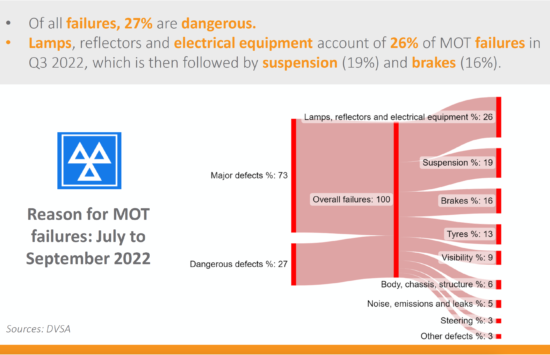Tyres behind 13% of MOT failures in 3Q 2022
 Sources: IAAF; GiPA; DVSA
Sources: IAAF; GiPA; DVSA
New analysis of DVSA MOT test data shows that faulty tyres accounted for 13 per cent of failures between July and September 2022. Of all failures, 27 per cent are “dangerous”. Previous analyses of MOT failure data have found that tyres account for between 8 per cent and 22 of all MOT failures. And therefore the latest figures represent long-term median tyre-related failure rates. Since industry sources generally agree that MOTs generate around 20 per cent of total annual UK tyre replacement sales, however you count it, MOTs have a significant impact on tyre maintenance and therefore road safety.
While some are suggesting stretching time till a car gets its first MOT, others are analysing the real-life data associated with MOT failures and the required associated maintenance. Indeed, the first Independent Automotive Aftermarket Federation (IAAF) Intelligence Report, produced in partnership with market analysts at GiPA, offers a breakdown of MOT failure rates from July to September 2022.
Other key takeaways from the statistics included further evidence that failure rates tend to peak in quarter four, with more than 30 per cent of cars failing in this period in 2021. Although 2022 findings are currently just below 30 per cent, these are expected to rise to be in line with 2021’s as a result of the ageing car parc, with figures still being confirmed.
The report goes even further to reveal that lamps, reflectors and electrical equipment accounted for 26 per cent of MOT failures in quarter three of 2022, which is then followed by suspension (19 per cent) and brakes (16 per cent).
Mark Field, IAAF chief executive, said: “As the past few years have proven, there are many factors that can affect all areas of the aftermarket, from new and ever-changing legislation, constantly evolving technology and a myriad of other influences; some of which are quite often unexpected or unprecedented. Together with GiPA, IAAF is continuously striving to offer members as much information as possible to ensure they are fully aware of market opportunities and demand, allowing the supply chain to fully service customers and their requirements.”



Comments